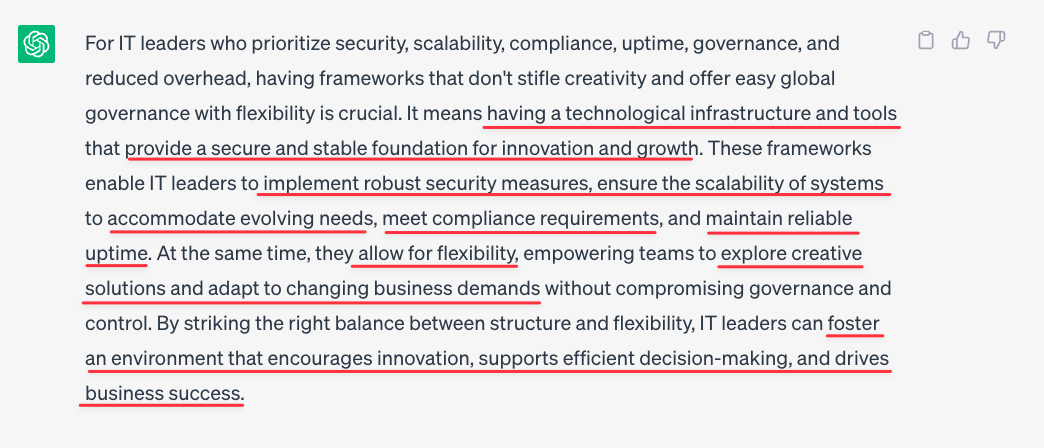Value proposition: How to know what to say
There's one thing that all master persuaders know...
It's not how to use words...
It's not how to hypnotize people...
It's not even how to use our own cognitive biases...
It's directional power.
What I mean by that is the direction of your thought or argument is way more powerful than its specifics.
Bold claims lead. Weak ones trail.
Scott Adams says:
This is why as we mentioned yesterday, in your value proposition the first things to get right are directional in nature:
- What to say (the points to hit)
- Where to say it (their priority)
So, while working on my client project, I experimented using ChatGPT to help guide me in the right direction.
I came up with a super simple prompt.
"What does it mean for PERSONA who want OUTCOMES to get VALUE?"
This obviously means that you first have to be clear on who your target customer is, what goals they want to achieve and what value you deliver that helps with those.
Here's an example for IT leaders:
 |
This is really helpful to start generating ideas. The response will be broad but it will guide you with the directional aspect of your value prop. It will start answering the questions of 1) What to say, and 2) Where to say it.
Here's the response to the previous prompt:
 |
I've highlighted the points I would hit in my value proposition.
If not all of them, at least the most important once. Notice the hierarchy and prioritization. We can't trust ChatGPT 100% but a simple cross-reference with our own research and we'd instantly know how to begin structuring our copy.
If you're struggling with finding the right direction for your claim, arguably the most important part of the argument, try this.
Quote and reflection of the day:
To get what you look for, be of service. The value you bring to the table has to come back to the source. Everything is in impermanent balance.
Cheers,
Chris
Hi, I'm Chris, The Conversion Alchemist
I'm the founder and chief conversion copywriter at Conversion Alchemy. We help 7 and 8 figure SaaS and Ecommerce businesses convert more website visitors into happy customers. Conversion Alchemy Journal is the collection of my thoughts, ideas, and ramblings on anything copy, UX, conversion rate optimization, psychology, decision-making, human behavior, and -often times - just bizarre, geeky stuff. Grab a cup of coffee and join me. Once a week, every Friday.
Read online Welcome to Unpacking Meaning. If you received this from a friend and enjoy it, subscribe here. How to find the story you’re probably missing Here’s something I didn’t realize for way too long. Every customer review is a compressed story. Not just feedback. Not just sentiment. A narrative with a beginning, middle, and end. Problem is, most of us read reviews like data points. We’re scanning for patterns. Looking for what comes up “a lot.” And in doing that, we miss that story. Let...
Read online Welcome to Unpacking Meaning. If you received this from a friend and enjoy it, subscribe here. How to write copy for your customers instead of at them “Do we really need to do interviews?” A client asked me this last month. We were scoping a messaging project, and when I mentioned customer interviews as part of the research, he paused. “Can’t we just use the data we have? The analytics? The surveys?” I get it. Interviews feel slow. They feel like a nice-to-have. And when you’re...
Read online Welcome to Unpacking Meaning. If you received this from a friend and enjoy it, subscribe here. How to systematically test your copy before it goes live Message testing has always meant one of two things: expensive user research you couldn’t afford, or shipping and hoping you got it right. You’d write the homepage. Get internal feedback. Maybe show a few friendly customers. Then launch and see what happened. If it worked, great. If it didn’t, you’d rewrite under pressure while...